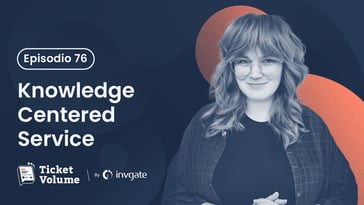Metrics can be subjective when measuring employee experience (EX), so you may as well embrace subjectivity by asking individuals how they perceive all the dimensions of their job. Once individual inputs are gathered, IT organizations can uncover themes and learn valuable information.
Maddie Blumenthal is here to assist companies in their search to measure the perception of experience from the other side of the keyboard. She provides valuable insights on how to accurately do it on the 27th Episode of Ticket Volume, our IT podcast. She discussed employee retention and onboarding and highlighted the vital role of the IT department in all of these aspects.
With a vast expertise in the industry, Blumenthal serves as the VP of Customer Success at QSTAC. Her impressive background includes working with renowned companies like FieldPulse, Verizon, Rainforest QA, and Bazaarvoice.
We highly recommend listening to the entire episode to fully immerse yourself in the experience. Additionally, we offer the option to register for our monthly live recordings, where you can actively participate and have your questions answered in real time.

An effective way to measure employee experience
Blumenthal explained in detail how QSTAC goes about measuring employee experience since its popularity stems from its ability to gather information about human interactions in IT support, being these employees actually their customers since they are using their technology. And it boils down to focusing on five key dimensions of experience:
- Quality
- Speed
- Technical knowledge
- Approachability
- Communication
Once the input is in their hands, the system provides both dimension scores and an overall score based on individual feedback. With that, users can drill down into specific dimensions to understand why certain scores were obtained. Yes, scores, not metrics.
|
|
"I'm a metric hater. I totally hate all metrics (...) Every time you're gathering information and putting it on a scale (...) this isn't a hundred percent accuracy. If we wanted true accuracy we would literally be reading our customer's diary and there's no way you can actually grok that kind of data exactly." Maddie Blumenthal |
She candidly delved into what she has learned from using this approach and shows how employees think their experience went. So, now it's time to take notes. Here are some of her insightful recommendations:
Segmentation for problem identification
Segmenting teams based on their office location and department (sales, marketing, engineering) can help identify problem areas. This segmentation allows for the identification of major themes and trends to develop a scalable strategy. For Blumenthal this is how you can go about it:
1. Addressing issues in specific buildings
When quality or speed ratings consistently decrease in a specific building, it is important to investigate further. Interviewing people in that building can provide valuable insights into the issues they are facing. Building trust with employees by assuring them that their feedback will be used to fix problems can lead to more specific and detailed information.
2. Improving survey response rates
Surveys are commonly used by IT departments, but sometimes the expected results are not obtained. To improve response rates, surveys should be kept anonymous to encourage honest feedback. Keeping surveys short and focused on solving specific problems helps accommodate busy schedules.
3. Communication within IT teams
IT teams often focus on technological advancements and projects, neglecting to communicate about existing products or services. It is important to share information about bug fixes and improvements with users to encourage continued usage. Being the champion and cheerleader for IT initiatives helps employees feel excited about their work and motivates them to improve.
As an IT manager, provide guidance on how to seek help and escalate issues to create a supportive environment.
Work-from-home setup and technology
Blumenthal discussed the relevance of having an efficient work-from-home setup. But, above all things, she pointed out that it’s having the right technology that’s crucial for companies to stay competitive in the workforce. That is why the role of the CIO (Chief Information Officer) has become more important in ensuring that employees have the necessary technology for their work.
Companies now spend thousands of dollars per employee on basic necessities. This is because it’s worth investing in employee well-being, including ergonomic setups and proper equipment, which is necessary for mental and physical health. Also, the quality of video calls and how employees are represented on screen can impact their experience and perception within the team.
And it’s all in the details; for instance, she recalled that she received a personalized welcome package when joining Verizon, and its positive impact on her as a new employee. Therefore, her tip is to check candidates' LinkedIn profiles before hiring, since personalizing the onboarding experience can leave a lasting impression.
|
|
"You're going to stay at the company where you feel like people are listening and where you're heard and you're not just another cog in the wheel." Maddie Blumenthal |
All of this to show that data-driven experiences tend to be more positive. So take the time to understand employees' interests, preferences, and motivations. For that, use technology to proactively seek information about employees' desires and goals and retain top talent. According to Blumenthal it is clear that in a competitive workforce, employees seek companies that provide the best technology and support for their success.
The truth is, similar to customer success, IT teams play a vital role in supporting employees by providing internal tools and infrastructure.
Bottom line
This is just a short recap of Ticket Volume's episode with Maddie Blumenthal, but there's much more on the recording. So, make sure to catch up on the full chat with Matt Beran to learn more about measuring employee experience which starts with creating a positive onboarding, providing the right tech, and considering the subjectivity of metrics.
The complete episode is available on Apple Podcasts, Spotify, YouTube, or your favorite podcast platform of your choice. Don't forget to subscribe if you wish to participate in the monthly live recordings!















